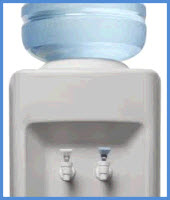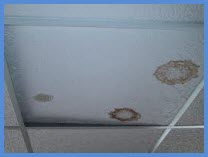Any data center manager can rattle off the standard list of critical facility equipment in the data center: generator, transfer switch, UPS, PDU, CRAC, fire system, etc. At times, however, one must take a step back and broaden one's view when determining what is critical. Unfortunately, too often we don't realize we're missing something important until after disaster strikes. In the hopes of heading off some future disasters, I share with you the following cautionary tale. I'll give you the take-away message in advance: "Look up!"
Scene: A corporate office tower in Anytown, USA. A data center consumes the bulk of one floor. It is an efficient, well-maintained data center, with dual, dedicated utility feeds supplying a 2N-redundant power system, backup generator, and redundant chillers. It also boasts a years-long history of non-stop 100% reliable operation.
 The office floors above the data center all have essentially identical layouts, consisting of conference rooms, cube farms, and the occasional honest-to-goodness office. Centrally located on each floor is an efficient, well-maintained kitchenette. In each kitchenette is a water cooler. Like many of its kind where the tap water is potable, this water cooler is plumbed directly to the sink. The ¼-inch white plastic tubing is anchored in place with small brass ferrules. This system has been doing yeoman's work for years, reliably delivering chilled, filtered drinking water to the employees with better than 99% up time, allowing for scheduled maintenance.
The office floors above the data center all have essentially identical layouts, consisting of conference rooms, cube farms, and the occasional honest-to-goodness office. Centrally located on each floor is an efficient, well-maintained kitchenette. In each kitchenette is a water cooler. Like many of its kind where the tap water is potable, this water cooler is plumbed directly to the sink. The ¼-inch white plastic tubing is anchored in place with small brass ferrules. This system has been doing yeoman's work for years, reliably delivering chilled, filtered drinking water to the employees with better than 99% up time, allowing for scheduled maintenance.
Action: Disaster strikes, in accordance with Murphy's Law, late one weekend night. The water cooler’s plastic plumbing finally succumbs to age and stress. Water streams onto the floor unchecked, quickly covering the linoleum surface and finding its way into the wall. There it heads in water's favorite direction, down, passing easily through the matching kitchenette walls in the identical floor plans below.
The water continues until reaching a floor with a dramatically different layout. Temporarily stopped in its pursuit of gravity, the water gathers its forces, soaking into the obstruction until eventually, like the plastic tube, the ceiling tile succumbs. The next obstruction happens to be a PDU and a couple of neighboring server racks in the data center. They too succumb, we assume rather spectacularly.
 Meanwhile, back in the kitchenette, the leak is discovered during a security sweep and the flow is cut off, but human intervention has come too late for the electronics down below. Power redundancy saved all servers that were not directly water-damaged, so only a few internal business applications took an uptime hit, along with the kitchenette. Over $100,000 of damage, thanks to the failure of a few pennies of plastic tubing in a “non-critical” part of the facility.
Meanwhile, back in the kitchenette, the leak is discovered during a security sweep and the flow is cut off, but human intervention has come too late for the electronics down below. Power redundancy saved all servers that were not directly water-damaged, so only a few internal business applications took an uptime hit, along with the kitchenette. Over $100,000 of damage, thanks to the failure of a few pennies of plastic tubing in a “non-critical” part of the facility.
Solution: One could easily focus on the data center itself and protecting its equipment: Place catch basins in the ceiling and extend the raised-floor leak detection system into them. That would help, and perhaps give a bit more warning. Not a bad idea in any case, if you have the time and money. Better solution? Inexpensive, off-the-shelf, floor leak detectors come in kits with automatic shut-off valves. Available online or in your local hardware store for home use in laundry rooms. An audible alarm is nice, but does an alarm make a noise if no one is there to hear it? Definitely get one with a second, normally-closed contact closure to link into your monitoring system. (You do have one, don’t you? Consider OpenData ME, SE, or EE!) Stop the leak early, and get advanced notice.
While you're at it, pick one up for that efficient, well-maintained, and oh-so-convenient second-floor laundry room in your home!
I hope you've enjoyed this tale. In the coming weeks, I'll share additional stories from the field as well as my musings on monitoring, instrumentation, and metrics. Visit my blog next week for insights on metering total energy for PUE—and a tip shared about the ATS.
